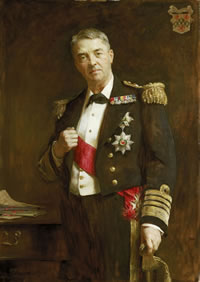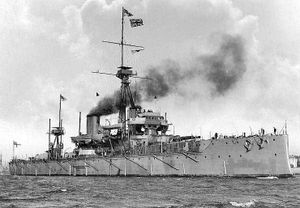April 28, 2006
Gratuitous Royal Navy Geek Posting
By request, no less!
It seems the British judge in the Da Vinci Code copyright case has been amusing himself by encoding a secret tribute in his verdict to this man:

Admiral Sir John Fisher.
Fisher was an early 20th Century reformer of the Royal Navy and also the mind behind the development of this ship:

H.M.S. Dreadnought.
The Dreadnought was launched in February, 1906, and apparently the Da Vinci Code judge wanted to mark the 100th anniversary of this occasion.
Frankly, I don't know that much about the Dreadnought other than that she was the first modern battleship (as we understand them), being bigger, faster and more heavily armed than anything else in the world. (Being a devotee of the earlier Age of Sail, I dismiss any vessel with an engine on it as a "stinkpot".)
I do know that her launch triggered a frantic arms race among all the Great Powers of the time, each one terrified that one of the others would develop an even larger version and thus gain dominion of the seas. Indeed, the race was so heated - particularly between Britain and Germany - that subsequent battleships were practically obsolete the moment they came off the slips. This race went on more or less until the rise of the aircraft carrier fundamentally altered naval tactics and did away with the primacy of the big gun battlewagon.
I understand that if you play a recording of the transcript of the verdict in the Da Vinci Code case backwards, you can hear the words "the Kaiser blows".
UPDATE: Speaking of the intensity of turn-of-the-Century naval rivalry between Britain and Germany, may I recommend Robert Erskine Childers' The Riddle of the Sands. This book, I understand, is generally credited as being the very first spy novel and tells the story of a couple of English gentlemen who sail a small craft about the southeastern coast of the Baltic, checking up on Fritz's diabolical plans for naval conquest under the nose of a dozing Admiralty. Frankly, I find the sailing bits of the story more interesting than the spying bits.
Childers wrote the book to goad HM Government into paying more attention to the German naval threat. A truly odd fish, he was a strange combination of patriot and gadfly and, ironically, wound up being shot for running guns to anti-British forces during the Irish Civil War in 1922.
Winston Churchill credited Riddle of the Sands with helping to bring about reform at the Admiralty and better military preparedness, but when he heard that Childers had been arrested said of the man, "No man has done more harm or done more genuine malice or endeavoured to bring a greater curse upon the common people of Ireland than this strange being, actuated by a deadly and malignant hatred for the land of his birth."
Posted by Robert at April 28, 2006 05:04 PM | TrackBackYou had me going there!
An excellent history of the people and events which brought about such people as "Jackie" Fisher and the ships themselves is DREADNAUGHT, by Robert K. Massie. Definitely not a boring list of specifications.
Alan
Robert Massie's two books, Dreadnought and Castles of Steel are a must for your reading list. The first is all about the building of the Dreadnought class, the second is about the naval war in WWI, when the ships Fisher built go to sea. Great, solid books. Beatty, Jellicoe, Churchill, Fisher -- great characters all.
Posted by: The Colossus at April 28, 2006 06:09 PMExcellent! I knew you'd have something fascinating to add!
Posted by: beth at April 28, 2006 08:14 PMObiter dictum: "The Riddle of the Sands" plays in the North Sea off the East Frisian and Dutch coast, not in the Baltic. You would know this if you had read the book.
Regards, Paul


 Image courtesy of the lovely and talented
Image courtesy of the lovely and talented 